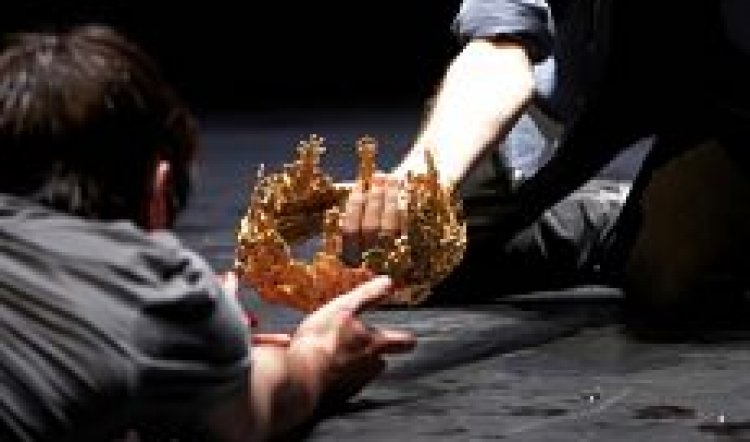
SYDNEY FESTIVAL/THE WAR OF THE ROSES
The War of the Roses, Parts 1 and 2, Sydney Theatre (STC and Sydney Festival) to February 14; see them in one hit with dinner at the Hickson Road Bistro in between (an excellent and convenient ’tween-wars treat) or separately; www.sydneytheatre.com
As his world crumbles and crashes about his murderous ears, Richard III (Pamela Rabe) famously wails, “A horse! A horse. My kingdom for a horse.” This plea signifies just how low and desperate he has become because all that has gone before, in the distillation into a marathon seven hours (plus dinner break) of eight of Shakespeare’s History plays, has taught us nothing if not that the kingdom – power – is all. To each successive monarch and ambitious aristocratic acolyte, the symbol of the kingdom – the crown – is the true object of desire.
This rather lovely doodad, specially designed and crafted for the production by Lisa Cooper, is grasped, grabbed, sought after, fought over, longed for and mourned in its inevitable losing. It’s as well that its maker did such a good job of it because the crown is the focus of attention from the opening moments as it rests on the head of Richard II, gleaming despite the all-enveloping, silently falling, glittering gold “leaf”.
Cate Blanchett, as Richard II and Rabe’s Richard III bracket the four sections of the play with contrasting bravura performances. Blanchett’s elegant, chillingly amused, assured, articulate and regal monarch is surely the kind of ruler monarchists have in mind when they squawk “God save the King!” In between are a selection of rulers that indicate why others might think it’s not such a good idea, culminating in Richard III. But more of him later.
The War of the Roses is nothing if not ambitious – hugely ambitious – and this kind of ambition is to be applauded, encouraged and resourced as best as possible if drama and its creators are to reach anything like their full potential. Benedict Andrews and Tom Wright adapted the plays and Andrews directs. In the main, they’ve both done a stunning job. So too has designer Robert Cousins. There are visual ideas in the set and the production that are quite brilliant.
The epic opens – in what is already a famous scene – as what looks like golden rain flutters hypnotically from high in the gods to an empty stage where stand the players, except the king who sits. As the play unfolds and the actors, unmoving, speak into the void, it suddenly becomes clear that stripped of movement and other distraction (set, props, period costumes) with the gentle glitter of gold providing the only visual stimulus, the text comes into focus as rarely before. Hypnotised by the soundless glimmer of gold and the statuesque actors, the words are all. It’s a brilliant idea, beautifully executed and an amazing effect.
Each part of War of the Roses is divided into two acts and in the first, Richard II is an elegaic character and the tone of the piece is at once muted and menacing. The earls are, as ever, vying for kingly favour and are restless. Family honour and advancement are paramount and the brewing trouble is focused on Bolingbroke (guest actor Robert Menzies who is agonisingly effective as the man with a troublesome conscience) and Mowbray (Steve le Marquand). Bolingbroke’s father John of Gaunt (John Gaden) is that rarity of the age: a man who died of relatively natural causes and after a reasonable span; but he does so with dire predictions for England’s future expressed towards a displeased king. Richard is forced to abdicate and Bolingbroke takes the crown as Henry IV.
(Those who may currently be experiencing a weird sense of deja vu, as the NSW ALP plays out its own low-rent version of this bit of history, won’t be surprised to know thatHenry is persuaded that it would be dangerous to allow Richard to live in what passed for the back benches of English regal politics.)
It’s not only the gold that dazzles in Part One, Act One. This is the last production to feature the STC Actors Company before it disbands and it’s the kind of enterprising, risky and different project I had always hoped it would be about. As it is, three-plus years down the track, the stars still sparkle, the troupe has visibly solidified into an assured unit, and the lesser lights remain, well, lesser.
John Gaden has rarely been better in his various roles here. He is dignified, icy and resigned by turns as the older patriarch of Part One, then, in the second act, he transforms into the rotund, jocular Falstaff. One of the most intelligent and electrifying scenes in the eight hours of the Wars is between jolly old Falstaff and young Prince Henry (Ewen Leslie). Much alcohol is being consumed by the pair as the apparently silly old buffer and the king’s arrogant son muck about, joking and larking merrily. Out of the blue the audience is given a swift kick in the pants and a stark message about the mores of the times when Henry casually opens the older man’s pants and, with as much passion and meaning as he might suck on a milk shake, fellates him. While Falstaff is in receipt of the pleasure, there is never for a second any doubt about who is servant and who is master. It’s a remarkable moment of theatre.

The Andrews-Wright adaptation of the plays takes us, in historical terms, through the century-and-a-bit of the deadly dynastic wrangles between the white rose of York and the red rose of Lancaster, with signifying buttonholes being replaced and ripped from breasts throughout. In Shakespearean terms, “real” history is put aside in favour of characters and dramatic licence. Nevertheless, as in most wars, the women fare badly. Only Marta Dusseldorp gets much to sink her teeth into – mainly as Margaret of Anjou – while Amber McMahon is required to stand mute and unmoving for all but 30 seconds of the first part and is a prince and a princess for the rest of the proceedings. Hayley McElhinney sees a little more action but not much. But that’s Shakespeare and it’s also the lot of women of the ruling and sub-ruling classes – not a reflection on the Mcs’ abilities.
Although there is much declaiming and not much light and shade in the middle two sections (a century of civil war and wretchedness will do that to you, probably) there are moments of unexpected splendour. Robert Menzies is responsible for many of those. In the main, the men have much more of the action, naturally, and no more effectively than in a remarkable “battle” scene. The chief protagonist of the conflict is not the usual fight director or fencing instructor, but a guitarist! Stefan Gregory is at the rear of the stage, back to the audience, as he fiddles with a wah-wah pedal, a control box and otherwise communes mainly with a large amplifer. Muted incidental sounds and chords fill in a background wash of aural colour to the otherwise bare stage as the story unfolds to where battle commences. Then, the combatants slowly assemble, long knives drawn, circling in a stately if ominous dance as the guitar and feedback building to a roaring, screaming crescendo: yet another brilliant idea and spectacle.
Another imaginative aspect of the production is the way the houses of Lancaster and York are evoked in the midst of the almost incredible panoply of murder, assassination, usurpation, war – civil and otherwise – rape and pillage that occupied England during the period. Blood and the spilling of it is a commonplace, as are ghosts and mourning. Murder after murder is enacted as a knifing followed by the perpetrator blowing a mouthful of scarlet liquid in the resigned face of the victim. It becomes almost farcical – as excessive violence tends to do – but after a few nervous giggles you begin to see how the childish act of spraying/spitting in a defenceless face is actually hideous, contemptuous and more shocking than a bullet or other conventional representation of killing. Then each death is followed by a cloud of fine white flour that gives the “corpse” a clownlike or white-ashed countenance that is also surprisingly shocking. And as the cloud of white hangs in the air, swirling gently above the stage the smoke of battlefields, the ghosts of decency and the departed and the misplaced pride in the red and white roses slowly disappears with it. Wow.
Finally, in the last part – otherwise Richard III – is one of the most memorable and resonant performances in this production. Any actor coming to Richard is also looking at omnipresent folk memories of Laurence Olivier, Ian McKellen and Antony Sher. You don’t have to have seen these three to know about them, think you know about them or have seen photographs, excerpts and documentaries of those performances that echo them. It’s possibly the most visually “remembered” role in Shakespeare. Smart move then to cast Pamela Rabe in the role. She is tall, lusciously womanly and beautiful; therefore she instantly banishes mental images of a misshapen, black-clad, predatory arachnid.
Her characterisation of Richard is also exceedingly smart. Again it seems that past history – real, Shakespearean and the above great stars – have been discarded in favour of a reading of the deadly prince and king that is logical, gut-wrenchingly plausible. The historical Richard was just 29 when he finally got his bloody hands on the crown, only to lose it and his life less than three years later. Rabe plays him as a boy and man who is uncertain of himself from the start and afraid of losing even that. His princely privilege sits uneasily on his shoulders and slips at any provocation. He is playful, coltish and charming one minute, the next his eyes, beneath a heavy fringe of heavy rock hair are glittering with crazy, threatened rage. He is born to rule and born to fear losing his birthright, so he is easily cruel and has no idea what it means. Neither does he understand love or appear to feel it: women are for alliances and use, men – beneath or above him – likewise. His emotions are what are twisted and crippled about him. It’s an extraordinary reading of Richard and more so as time passes.
Where the first part of The Wars is played out in a golden void, the last part is set in a dour evocation of a children’s playground. In it a slippery dip, a roundabout, a climbing frame and swings all seem to mock Richard’s sometimes childlike view of the world and his place in it. And instead of gold, out of the sky – as he mutters about his winter of discontent – falls snow that reaches the ground and reveals itself to be grey and thoroughly unappealing. It looks like the ashes that fall from volcanic eruptions, or perhaps an idea of acid rain – or just the imagined outcome of a dead, hopeless and shriveled world. Whatever it’s supposed to be, it reflects the sour wasteland of Richard’s soul.
Despite the longueurs of the middle sections, The War of the Roses is a remarkable achievement and, in this summer of our discontent, we are made merry by the sons and daughters of former artistic director Robyn Nevin (it must be acknowledged). It remains my view that the actors probably got more out of the Actors Company than did audiences (“oh not him/her again”), but when they delivered something out of the ordinary – The Lost Echo, Gallipoli and now this wrenching epic – they surely did deliver. There are lessons there for the Blanchett-Upton era and signs are they are already being absorbed.



